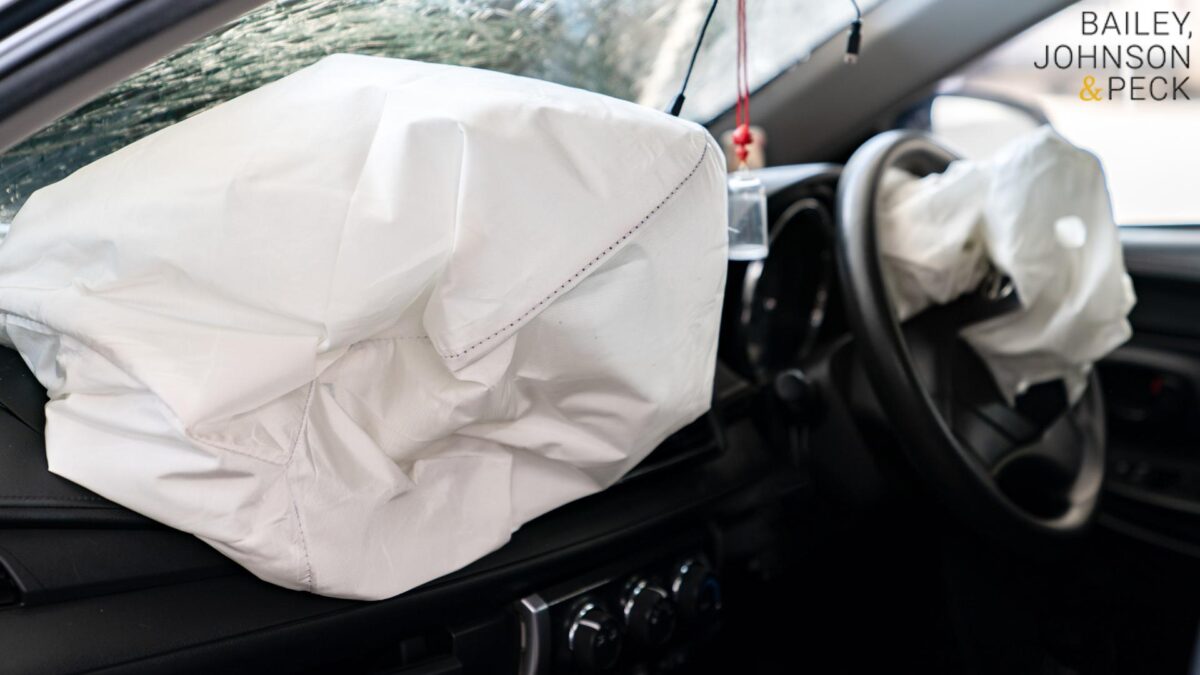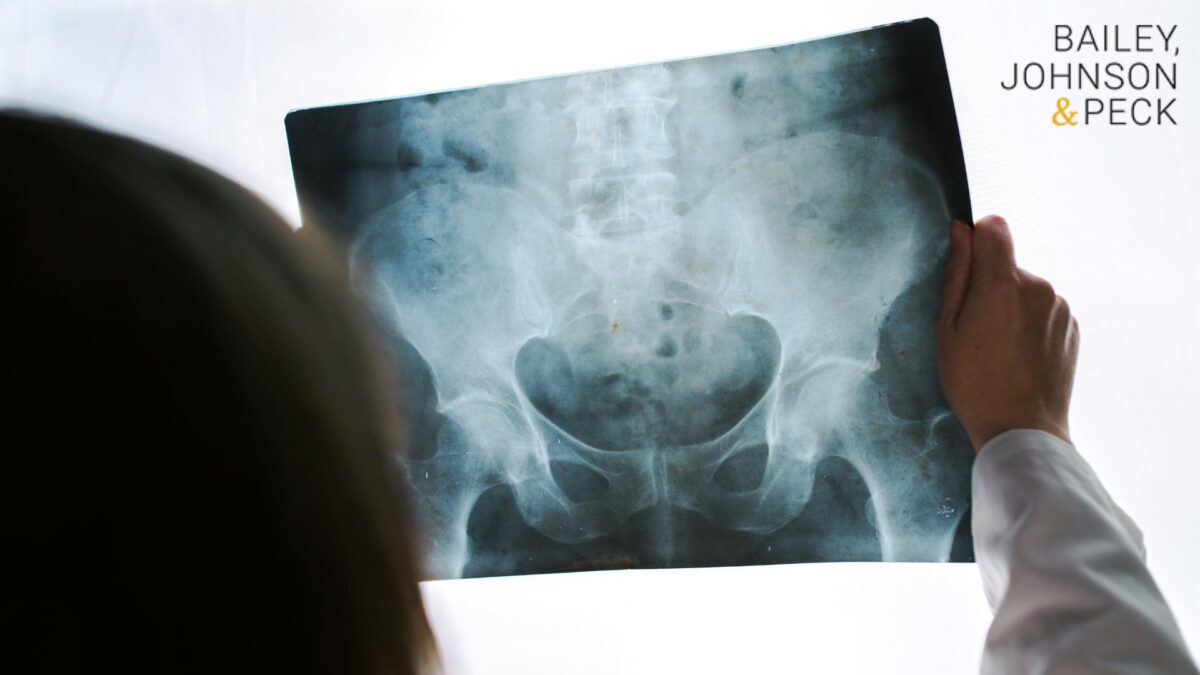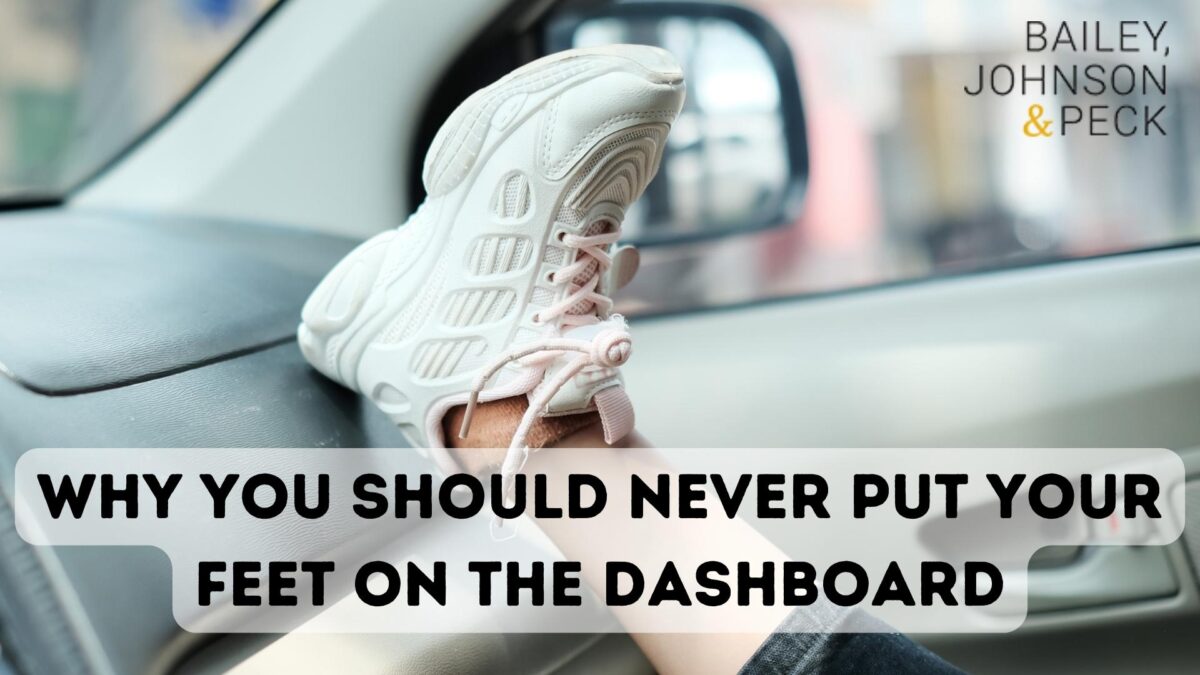You may want to stretch your legs out and prop them up on your dashboard when traveling on a long road trip. However, that’s the last place you want to put your feet in case you’re suddenly the victim of a car crash.
Even though our vehicles are designed to protect us during a car accident, we can suffer serious injuries when we don’t sit correctly. In our latest blog, the Albany car accident attorneys from Bailey, Johnson, & Peck, P.C. will explain why putting your feet on the dash is dangerous and can lead to life-threatening injuries.
You can pursue legal action against the at-fault driver if you suffered injuries following a car accident. To learn more about your legal options, schedule a free consultation by calling 518-456-0082. Our experienced attorneys are ready to help you recover compensation for your injuries.
Why You Should Never Put Your Feet on the Dashboard
You may never think you’ll get into a wreck someday, but a Georgia woman warns others now of the dangers of sitting with your feet propped up on the dash. Audra Tatum was repeatedly cautioned that sitting with her legs crossed on the dashboard was dangerous, but she simply ignored them. In 2017, Tatum was involved in a T-bone accident where she suffered catastrophic injuries, stating that her entire right side was completely crushed. Even though she’s been unable to return to work, she can now walk without assistance. The accident that Tatum was involved in is just one of the scenarios that can happen when you sit with your feet propped up on the dash.

Airbag Deployment
Drivers involved in car accidents can often suffer airbag injuries. While airbags deploy to keep us safe, they can actually harm drivers and passengers in the process. An airbag will inflate in as little as 20 to 30 milliseconds, traveling forward at 30 miles an hour and hitting a front-seat passenger in the chest. So imagine what that airbag can do when it doesn’t have to travel and hits your feet and legs that are propped up on the dashboard?
The injuries a passenger can sustain when airbags deploy will vary based on how your legs are positioned on the dashboard. A passenger with their feet on the dash and their knees pointing to the roof can have their knees shoved into their eye sockets, the Chattanooga Fire Department warns. In addition to suffering eye and vision damage, you could also suffer a broken nose, dislocated hips, and multiple leg bone breaks.
Passengers that sit with their feet and legs straight over the dash can have their legs forced upward, causing the hips to be completely dislocated and the legs top break in multiple places. Another dangerous position is when passengers criss cross their legs and feet on the dashboard. In this position, your knees are pointing out toward the sides, which can cause airbag injuries like leg breaks and hip joint damage. Even though the injuries from placing your legs and feet on the dash are not necessarily life-threatening, they can leave passengers permanently disabled. Other passengers may need months or years of physical therapy in order to walk normally again.
The above scenarios should show how dangerous airbags can be for passengers that aren’t sitting in the proper position.
Lack of Protection in a Rollover Accident
If you’re involved in a rollover accident, having your legs and feet on the dashboard can prevent you from being protected during the crash. When passengers aren’t sitting upright, the airbags are not able to do their job correctly because their legs and feet are in the way.
In a rollover accident, the head, neck, and whole right side of the body are more susceptible to injuries since your legs and feet obstruct the airbags. When airbags cannot protect passengers or are deployed in a dangerous way, there’s a higher possibility that the injuries will be more severe and life-threatening.
Lack of Seat Belt Protection
When a passenger has their feet on the dash, they won’t be adequately protected by their seatbelt. During an accident, the lap belt is supposed to hold your hip and pelvic bones in place. The lap belt moves toward the upper body if a passenger’s feet and legs are on the dash. In this position, it pushes on internal organs, like the liver and intestines, leading to severe organ damage and internal bleeding.

Possible Horrific Injuries From Putting Your Feet on the Dashboard
Vehicles are designed to protect us in the event of a car accident, so when passengers don’t sit correctly, they risk suffering catastrophic injuries. Below, we’ll detail the various horrific injuries sustained when passengers do not sit in the correct position. Even a minor accident has the potential to cause injuries.
- Traumatic brain injuries (TBI) like subdural hematomas, concussions, a brain leak of cerebrospinal fluid, and more
- Back and spinal cord injuries
- Facial and skull fractures, like a broken nose
- Eye loss and/or vision damage
- Partial or complete paralysis
- Multiple broken bones
- Hip dislocations
- Amputations of feet or legs
- Seatbelt syndrome – internal bleeding and organ damage
- Permanent scarring, disfigurement, and/or disability
Other Unsafe Seating Positions in the Car
Propping your feet on the dash isn’t the only position that can be dangerous when you’re sitting in a vehicle. Passengers can suffer catastrophic injuries in other unnatural seating positions as well, including:
- Sitting with Legs Crossed: When you’re sitting cross-legged, it’s not as dangerous as when your legs are on the dash. However, you are still at risk of suffering injuries to your knees, hips, and pelvis.
- Leaning Back Too Far: When you’re reclined too far back, there’s too much space between the airbag and your head. This can allow your head and body to move around, leading to whiplash and other injuries.
- Slouched Over: When your head and neck are slumped forward, the airbag can deploy straight into your face and head, potentially snapping your neck or causing other head and neck trauma.
- Poorly Positioned Headrest: The positioning of your headrest is critical to protecting you in the event of an accident. The headrest is there to keep your head and neck as still as possible during an accident. If your headrest is not positioned correctly, you could risk severe injuries like whiplash, a concussion, or other traumatic brain injuries.
- Sitting Too Close: As we’ve mentioned above, airbags are deployed at high speeds. When you’re sitting too close to the dashboard (or steering wheel for drivers), the impact from the airbag will be much more severe. You can suffer lacerations, skull and facial fractures, bruising, and traumatic brain injuries depending on where the airbag hits you.
- Sitting in the “Airplane Position”: In an airplane crash, passengers are told to tuck their heads between their knees to lower their chances of serious injuries. On the other hand, this is NOT the position you want to be in during a vehicle crash.
How Should a Front Seat Passenger Sit in the Car?
Passengers and drivers should always sit in an upright position with their feet on the floor and seatbelts positioned correctly across their chests. Drivers need to sit at least 10 inches from the steering wheel, and passengers should be at least one foot away from the dashboard. Sitting correctly in a vehicle may not prevent injuries in the event of an accident, but it can help you decrease your chances of suffering life-altering injuries and permanent disabilities.
Can You Sue for Car Accident Injuries?
Yes, if you were involved in a car accident that was caused by another driver’s negligent actions, you could sue for damages. The experienced Albany personal injury attorneys at Bailey, Johnson, & Peck, P.C. will work diligently to recover compensation for your injuries by proving the four elements of negligence occurred.
- Duty of Care: All drivers owe a duty of care to other motorists and passengers. This means driving carefully and not recklessly or negligently.
- Breached Duty of Care: When a driver ignores their duty of care and behaves recklessly or negligently behind the wheel, they put all other drivers and passengers at risk.
- Causation: The other driver’s actions caused the accident and injuries.
- Damages: The victim suffered injuries and other damages for which they deserve financial compensation.
Car Accident Damages
The attorneys at Bailey, Johnson, & Peck, P.C. have recovered the following damages for clients involved in car accidents:
- Medical expenses, both past and future
- Physical therapy
- Property damage
- Lost wages
- Loss of earning capacity
- Medical equipment, like wheelchairs and other mobility aids
- Counseling expenses
- Physical pain and suffering
- Funeral and burial expenses if the accident resulted in wrongful death
Call Albany Car Accident Lawyers at Bailey, Johnson & Peck Today
If you were involved in a car accident caused by a negligent driver, you have the right to pursue compensation for your injuries. The personal injury attorneys at Bailey, Johnson, & Peck, P.C. have helped Albany residents for over 40 years in their car accidents and other personal injury cases. To discuss your case with one of our compassionate attorneys, schedule a free consultation by calling 518-456-0082 today.




